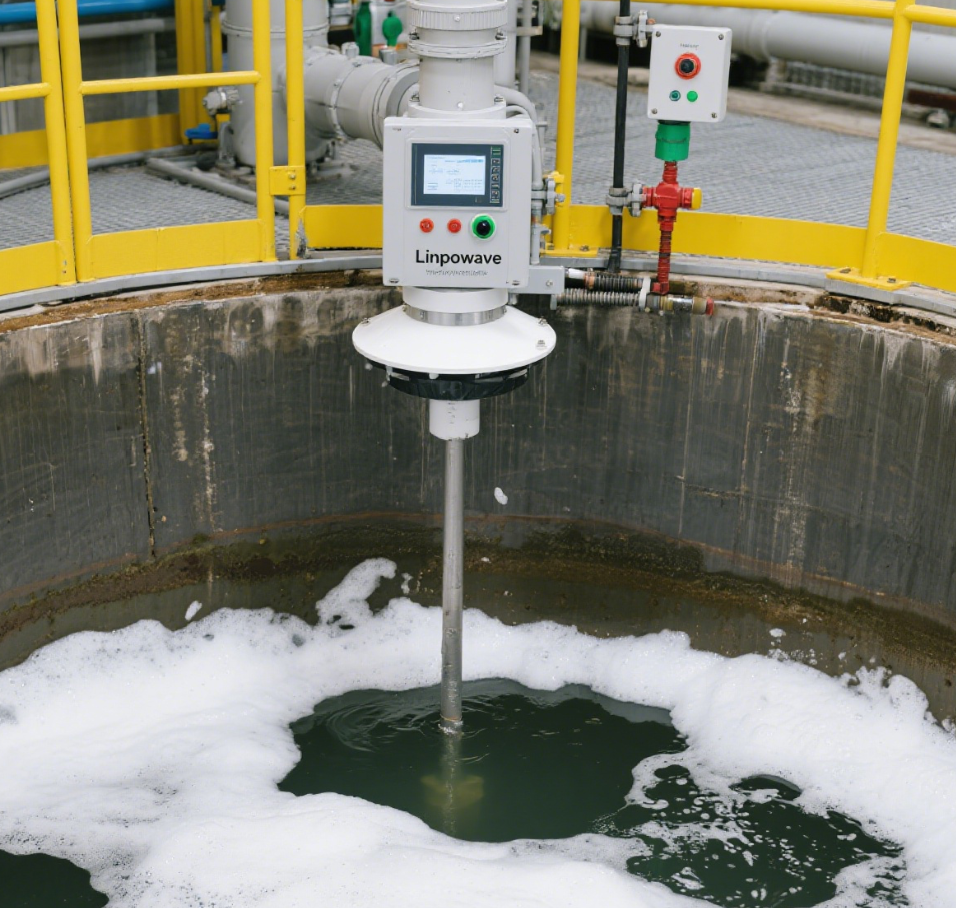1. Introduction
Accurate liquid level monitoring is critical for wastewater treatment plants and industrial process tanks. Foam formation, a common byproduct of aeration, chemical reactions, or biological processes, presents a unique challenge for traditional sensors.
Ultrasonic, float, and pressure-based sensors often fail in foam-rich environments, as foam layers absorb or scatter signals, resulting in false readings, delayed alarms, or even operational disruption. For instance, in aerated municipal wastewater tanks, foam thickness can vary from a few centimeters to over 20 cm, making real-time monitoring highly complex.
Linpowave millimeter-wave radar sensors offer a robust solution. By combining high-frequency radar waves with intelligent signal processing, these sensors detect the true liquid surface beneath foam, providing reliable measurements without direct contact. This ensures operational stability, reduces maintenance, and supports automated control systems.
2. Challenges of Foam Interference
2.1 Signal Attenuation and Scattering
Foam consists of gas bubbles enclosed by liquid films, creating a heterogeneous, reflective surface. This can interfere with conventional sensors:
-
Ultrasonic sensors: Sound waves may be absorbed or deflected, generating erratic readings.
-
Pressure sensors: Trapped gas pockets lead to false pressure values.
-
Optical sensors: Uneven foam surfaces create inconsistent reflections and measurement noise.
High-frequency millimeter-wave radar (76–81 GHz) can partially penetrate foam layers and reach the underlying liquid, significantly improving measurement reliability.
2.2 Variable Foam Density
Foam thickness and density fluctuate due to aeration intensity or chemical dosing. Traditional sensors cannot adapt quickly to these dynamic changes, resulting in unstable readings.
Millimeter-wave radar sensors overcome this with dynamic thresholding and echo processing. They filter out transient signals from bubbles, ensuring a stable, accurate measurement of the liquid surface even in aerated, foam-rich tanks.
3. Advantages of Millimeter-Wave Radar
3.1 Foam Penetration Capability
Millimeter-wave radar emits short-wavelength electromagnetic waves capable of penetrating thin foam layers. This is particularly valuable in wastewater or chemical tanks with rapid foam formation.
3.2 Non-Contact Measurement
Non-contact installation prevents fouling and reduces maintenance requirements. Sensors remain above the foam, avoiding disturbances from liquid agitation, turbulence, or chemical residues.
3.3 Intelligent Signal Processing
Linpowave sensors employ advanced algorithms to distinguish real liquid surfaces from noise:
-
Echo filtering: Eliminates multiple reflections caused by foam.
-
Peak detection: Identifies the true liquid surface.
-
Averaging algorithms: Stabilize readings in turbulent or aerated environments.
Reference: Radar Level Sensors Overview
4. Industrial Applications and Examples
4.1 Wastewater Treatment Plants
In municipal wastewater tanks, foam formation during aeration can vary dramatically. Millimeter-wave radar sensors provide:
-
Accurate level monitoring despite thick or variable foam.
-
Prevention of overflow or dry-running pumps, ensuring operational safety.
-
Seamless integration with SCADA systems for automated control.
Example: A medium-sized wastewater treatment plant in California installed Linpowave sensors in aeration tanks with foam layers up to 15 cm thick. The radar maintained stable readings, reducing pump errors by 40% compared to previous ultrasonic sensors.
4.2 Chemical Process Tanks
Foamy chemical mixtures in intermediate tanks pose a similar challenge. Linpowave sensors:
-
Ensure continuous monitoring without maintenance interruptions.
-
Provide reliable data for automated chemical dosing, improving process consistency.
-
Reduce downtime due to sensor cleaning or replacement.
Example: In a foam-generating polymer reaction tank, Linpowave radar measured liquid levels accurately during high aeration phases, maintaining ±5 mm precision.
5. Practical Recommendations
-
Optimal Sensor Placement: Install at the tank center, avoiding walls and baffles to minimize false reflections.
-
Parameter Tuning: Adjust gain, thresholds, and averaging settings to accommodate foam thickness.
-
Regular Calibration: Periodically verify sensor readings against reference levels for long-term accuracy.
-
Maintenance Checks: While non-contact, inspect the area above the tank for dust, condensation, or other obstructions.
6. FAQ: Foam Interference in Level Measurement
Q1: Can foam thickness completely block millimeter-wave radar signals?
A: Millimeter-wave radar can penetrate most thin to moderate foam layers. Extremely dense foam may slightly reduce signal strength, but intelligent signal processing filters out noise to maintain accuracy.
Q2: How often should radar sensors be calibrated in foam-rich tanks?
A: Calibration every 6–12 months is recommended, depending on aeration intensity and chemical composition, to ensure stable readings.
Q3: Will liquid agitation affect radar measurement in foam-rich tanks?
A: Non-contact radar sensors measure from above and use averaging algorithms, minimizing the effects of turbulence and foam fluctuations.
Q4: Are millimeter-wave radar sensors suitable for all wastewater types?
A: Yes, including municipal, industrial, and chemical wastewater, as long as foam is within typical operational ranges. For highly unusual foams, sensor settings may need adjustment.
7. Conclusion
Excessive foam in wastewater or chemical tanks poses a significant challenge for accurate liquid level measurement. Linpowave millimeter-wave radar sensors overcome these challenges through:
-
High-frequency radar capable of penetrating foam layers
-
Non-contact design minimizing fouling and turbulence impact
-
Advanced signal processing ensuring stable and reliable readings
Deploying millimeter-wave radar ensures maintenance-free, precise monitoring, improves operational efficiency, reduces risks, and supports compliance with regulatory standards.
Call to Action: Learn more about Linpowave millimeter-wave radar solutions to achieve accurate liquid level measurement in foam-rich tanks.



